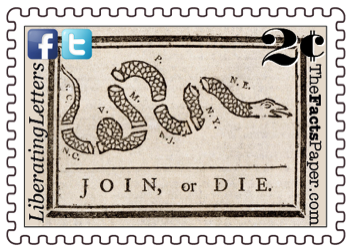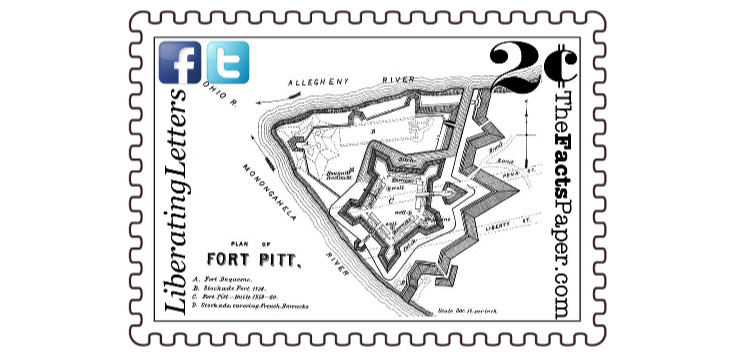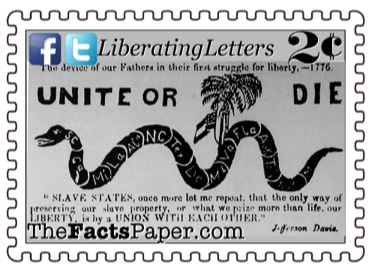Just shy of a century later, G. W. Falen redesigned the cartoon again during the Civil War to unite the slave states as America now experienced a deep division amongst her own people. (see Disunity Of The Union) Becoming a symbol of unity and liberty, Christopher Gadsden used a rattlesnake on a yellow field with the words “DON’T TREAD ON ME” on his 1775 flag. The famous Gadsden flag was used by the Continental Marines, and was revived during the 2010 Tea Party movement in their fight for limited government. (see Tyrants And Tea Parties)
Liberty, as I have been writing to you for years, we are in another crucial battle in America. Possibly the most important battle ever. It is a fight of good verses evil, Capitalism verses Socialists, Individualists verses Collectivists, and Judeo/Christian conservatives verses those who have completely abandoned God. Socialists and Globalists have quietly overtaken our schools, universities, and internal cogs in our society during the past century. Now, with people in power as well as minions in everyday citizens, they are going full bore towards their goal: top down, bottom up, and inside out. With government officials pushing from the top and millennials shoving from the bottom determined to turn Middle America inside out, making it a full socialist country, they continue to divide Americans in as many ways as possible.
When Franklin first produced the ‘Join, or Die’ cartoon, we were facing a war of Britain against France. During the Revolutionary War, colonists disagreed with the British government in England. The Civil War divided the country into Northern states against Southern States. Today, political discord is separating family members, including those residing the same house. We have been reduced to quarreling within our most intimate relationships because progressive socialists know when Americans unite, they will outright reject their ideology.
In both the American Revolution and the Civil War, Washington and Abraham Lincoln found a solution. They changed the course of their wars by getting on their knees and praying with all humility for God to protect America. In both conflicts, the tide turned and the Patriots and Union won. (see God’s Divine Providence) Today’s atmosphere is no different from those prior times and neither is the solution. We must quickly unite. In addition, we must fall on our knees, and pray for God’s mercy, or else our country’s liberty will die forever. As God told us, “If my people, who are called by my name, will humble themselves and pray and seek my face and turn from their wicked ways, then I will hear from heaven, and I will forgive their sin and will heal their land.” 2 Chronicles 7:14. He has given us the answer. The question is, will America heed it this time?
That’s my 2 cents.
Love,
Mom
Following the war, Parliament began imposing taxes to pay for the war and quartering soldiers in a time of peace. Colonists believed the war was Britain’s, not theirs, and should not be held responsible for any more expenses than they already incurred. Several such conflicts between Parliament and the people eventually led to Americans standing against their mother country. (see Tree Of Liberty, Acts of Oppression, Mayhem And Massacres, Tyrants And Tea Parties, The Forgotten Battle, and The Shot Heard Round The World) Despite the colonists uniting against France in the Seven Years War, they became a vital Ally of the colonists just about a decade later, helping Washington defeat the British in the American Revolution at Yorktown. (see On A Mislead And A Prayer)
Franklin’s cartoon was revived in 1765, just two years after the French and Indian War, in response to the passage of the Stamp Act. Now including Georgia, Patriots realized war was once again imminent, yet this time, they needed to unite to fight the motherland or be enslaved and dominated by the crown forever. On July 7, 1774, Paul Revere used an altered version on the masthead of his Massachusetts Spy, as the American Revolution was seen on the horizon.
May 9, 2019
Dear Liberty,
From the time European settlers began setting foot on the Eastern shores of the New World, there was a battle over territory. Yet it wasn't necessarily the natives against the settlers. The French, British, Spanish, and Dutch all laid claim to areas in the vast unsettled land, often times with overlapping boundaries, as with the Ohio Valley. The natives, who enjoyed thriving trading relationships with the different countries often chose sides, fighting rival tribes to maintain those prosperous alliances.
The French began settlements in Canada, establishing fur-trading endeavors with the Algonquin and the Hurons. Spanish colonies, settlers, and traders focused on the southern areas, such as Florida and below. The Dutch enjoyed a beaver pelt trade with the Iroquois-confederation, also known as the Five Nations, a relationship they cultivated since buying Manhattan Island from them in 1624. (see Wampum On The Dollar) Fur trading was so important for the natives, the Iroquois often stole animals from traps of other tribes as well as pelts from their canoes. The animosity was so great, they eventually eradicated the Huron from the French lands north of Lake Ontario.
The influx of British settlers, and the English's growing desire for trade with the natives, forced the Dutch to surrender New Amsterdam on Manhattan Island to Britain on September 8, 1664, giving them the monopoly of the eastern coast. The British renamed it New York City and New Netherlands became New York State. They also assumed the productive trade relationship with the Iroquois, including other trade goods and weapons. The Dutch continued to weaken while Spanish influence also declined in the New World by the end of the 17th century as France and Britain pushed to expand their footprint and dominate America.
At war for centuries in the Old World, jealousy and animosity between the two countries divided by religion, language, and laws drove them to continue their bloodshed on a second continent. As Europe waged their battles for land, the colonies always experienced the casualties, whether it be livestock, property, goods, their lives, or just peace. Four major wars covered America with blood long before the colonists began their fight for independence: King William's War from 1688-1697, the War of the Spanish Succession, or "Queen Ann's War," from 1702-1713, and the War of the Austrian Succession, or “King George’s War,” from 1740-1748. Britain and France's final rivalry in America culminated in the Seven Years' War, also known as the French and Indian War.
In 1713, France surrendered the areas of Nova Scotia, Newfoundland, and the Hudson Bay region to Great Britain, yet they were not out of the fight. They continued to travel through the interior of the country, down the Ohio Valley and along the Mississippi, setting up forts and trading posts. The British had only a handful of such posts beyond Virginia and Pennsylvania. France's goal was to keep the British confined to the land east of the Allegheny Mountains while they moved further west. As they did so, French traders began visiting small Indian towns the British considered their exclusive trading areas. While boldly pushing their way eastward towards British territory as well.
Seen as an intrusion on their territory and trade with the natives, Virginia’s Lieutenant-Governor Robert Dinwiddie took action. As part of the Ohio Company, founded along with Lawrence and Augustus Washington, and other Virginia planters in 1794, Dinwiddie challenged France’s claim to the Ohio Valley. Since King George II granted them a charter of 200,000 acres around the Ohio River’s headwaters called the Point, a prominent position on the Western front where the Allegheny and Monongahela Rivers meet the Ohio River, Dinwiddie was not giving up such an important location easily. Therefore, the Ohio Company commissioned 21-year-old Major George Washington to deliver a letter informing the French to evacuate the area immediately. Leaving in October of 1753, along with Jacob Van Braam and surveyor and frontiersman Christopher Gist, Washington stopped first to hold council with the Delaware and other natives in the area, who pledged their support to Britain.
The group arrived at Fort Le Boeuf in Venango on December 11. While the men were cordially received, the demand was adamantly rejected in a letter given to Washington to return to Dinwiddie.
As Washington returned home, the French overtook the Point. They demanded Britain’s Captain William Trent surrender Trent’s Fort, which he did. They then destroyed the fort, immediately starting construction on Fort Duquesne. A journal published by Washington of his two and a half month journey helped inform the British of France’s imminent threat in the Ohio Valley.
With another war between France & Britain looming, the settlers in the British colonies were deeply divided as to whether to support expansion beyond the Appalachian Mountains and backing the mother country. Therefore, an Albany Congress convention was scheduled for delegates from the colonies to convene and discuss options for dealing with the French and possible treaties with the Indians. As the convention approached, leaders such as Benjamin Franklin, started introducing the idea of uniting the colonies in a central government, still under the crown, to more easily address the issues of those in the New World. To present his argument, Franklin took to his Pennsylvania Gazette to address the colonists. (see A Tale Of Two Printers)
At the time, people believed the myth that if a snake were divided into parts, if the pieces were reunited before sunset the snake would live. Using that imagery, Franklin produced a woodcut that became the first political cartoon in the colonies. Published on May 9, 1754, and entitled "Join, or Die," the picture accompanied an article Franklin wrote encouraging the settlers to unite behind Britain or they would finally be defeated by France.
"The Confidence of the French in this Undertaking seems well-grounded on the present disunited State of the British Colonies, and the extreme Difficulty of bringing so many different Governments and Assemblies to agree in any speedy and effectual Measures for our common defense and Security; while our Enemies have the very great Advantage of being under one Direction, with one Council, and one Purse.”
Franklin continued, warning the French would use violence against the colonists, taking “an easy Possession of such Parts of the British Territory as they find most convenient for them; which if they are permitted to do, must end in the Destruction of the British Interest, Trade and Plantations in America.”
To emphasize his point, Franklin's cartoon displayed a snake divided into 8 pieces. Each part was labeled as a colony, with one segment representing several New England colonies. As part of Pennsylvania at the time, Delaware did not have a section, and neither did Georgia, which existed more as a buffer between the English colonies and Spanish Florida and not truly involved in the events of the conflict. However, the message was clear. Time was running out and the people needed to unite, or they would die as separate entities. He used a similar analogy after signing the Declaration of Independence, stating, "We must all hang together, or assuredly we shall all hang separately." (see The Forgotten Midnight Ride)
As Franklin worked to band the civilians together, newly promoted Lt. Colonel Washington marched troops north to confront the French at Fort Duquesne. He led an ambush on the French with the help of Mingo chief Tanacharison at the Battle of Jumonville on May 28, 1754, setting the stage for the beginning of the French and Indian War.
Seven colonies sent representatives, including Franklin from Pennsylvania, to the Albany Congress convening on June 19 to establish a treaty with the Iroquois Confederation. While options were explored, discussions soon moved to developing a centralized government for the British colonies within North America, yet still under the crown’s authority. Led by Franklin, a formulated proposal passed the Congress on July 10, 1754. While Britain liked the idea of a local government in the New World to immediately address the colonists’ issues, they failed to push the proposal through Parliament worried the settlers would realize they could govern themselves. Yet Franklin did not let the work go to waste. As Americans designed the Articles of Confederation and then the Constitution, the Albany Plan was used as a template for both documents.
After the Constitutional Convention ratified the Constitution, Franklin surmised in 1789 that if the crown would have passed the Albany Plan, the fight for independence may have been delayed. He wrote, “For the Colonies, if so united, would have really been, as they then thought themselves, sufficient to their own Defence, and being trusted with it, as by the Plan, an Army from Britain, for that purpose would have been unnecessary: The Pretences for framing the Stamp-Act would not then have existed, nor the other Projects for drawing a Revenue from America to Britain by Acts of Parliament, which were the Cause of the Breach, and attended with such terrible Expence of Blood and Treasure: so that the different Parts of the Empire might still have remained in Peace and Union.” In other words, the King’s reluctance to give the colonies the ability to govern themselves out of fear they would want independence only accelerated that desire. (see Tree Of Liberty and Acts Of Oppression)
As their demise became imminent, the French destroyed Fort Duquesne, yet the British built another fort at the same site naming it Fort Pitt after Prime Minister William Pitt the elder, who helped win the conflict. Pittsburgh honors this historic site at Point State Park, where a museum and brick outlines exhibit the locations of the forts that once controlled the area.
JOIN, OR DIE






